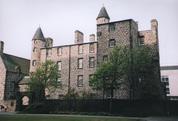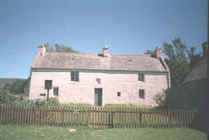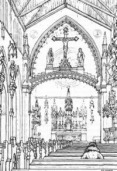A Brief History
Unleashing Life
"I have come that they might have life and have it to the full." Jn 10:10
"I have come that they might have life and have it to the full." Jn 10:10
In August 1560 a parliament met in Edinburgh which abolished the authority of the Pope, adopted a reformed Confession of Faith and forbade the celebration of the Mass. The legislation then enacted Aberdeen, as it did the rest of the country, so far as the destruction of the organisation of the Catholic Church was concerned. But the organisation of a new Church was very different matter and aroused no local enthusiasm. No native Protestant leader is to be found in Aberdeen, and none of the local clergy, secular or religious, became an active Protestant. John Knox did favour Aberdeen with a visit in 1564 but, though he is not slow to record his achievements elsewhere, he is discreetly silent about his reception here. A number of clergy kept to the practice of the Catholic religion right up to 1600 and even later. Older men like the diocesan treasurer, Patrick Myrton, continued to say Mass long after it was made illegal.
 But long before the pre-Reformation clergy died out new missionaries, mainly Jesuit Fathers, had appeared in Aberdeen. There were secret chapels - one can still be seen in Provost Skene's house. That does not mean that it was easy or possible to attend Mass regularly, far from it; but there were always priests about. Indeed the story of Catholicism in Aberdeen is unique in Scotland in that it has been unbroken and continuous. Not only have there always been Catholics, but Catholic priests have always been within easy reach.
But long before the pre-Reformation clergy died out new missionaries, mainly Jesuit Fathers, had appeared in Aberdeen. There were secret chapels - one can still be seen in Provost Skene's house. That does not mean that it was easy or possible to attend Mass regularly, far from it; but there were always priests about. Indeed the story of Catholicism in Aberdeen is unique in Scotland in that it has been unbroken and continuous. Not only have there always been Catholics, but Catholic priests have always been within easy reach.
From 1687 we have a regular series of priests in charge of Aberdeen, usually with other priests as guests who shared their work. Towards the end of this period a Vicar Apostolic (one of the three unofficial bishops for the Scotish Mission) might be resident in Aberdeen and helping in the pastoral duties when not himself engaged in visiting the other missions of the district. This stretched as far to the west of Kintail and as far to the north as Orkney.
The first of these bishops took charge in 1694. He was Thomas Nicholson and he came from the heartland of Catholicism between Fochabers and Buckie. The Jesuits recaptured most of the Upper Deeside for Rome and also provided a welcome stimulus to Aberdeen's Catholics, but the rivalry caused by the existence of two chapels in this small city, only one of which was effectively under the Bishop's control, was sometimes unhealthy.
 The first Catholic bishops appointed after the Reformation, Thomas Nicolson and his assistant James Gordon, saw the need early in the century for places in Scotland where intending priests could begin their education or even complete their courses to ordination. Several tiny colleges were set up at different times for this purpose, mostly in the West Highlands, but the most important and lasting of these was at Scalan.
The first Catholic bishops appointed after the Reformation, Thomas Nicolson and his assistant James Gordon, saw the need early in the century for places in Scotland where intending priests could begin their education or even complete their courses to ordination. Several tiny colleges were set up at different times for this purpose, mostly in the West Highlands, but the most important and lasting of these was at Scalan.
From 1717 to 1799 about one hundred future priests were given the equivalent of secondary education in this little seminary, a remarkable achievement for these troubled times. Most completed their courses in Italy, France or Spain, but at least two were ordained at Scalan without study abroad. This little college ensured the survival of Scottish Catholicism. A few decades later when Irish Catholics began to arrive in large numbers, especially in the West of Scotland, Scottish priests were there to meet them at the ports.
In mid-18th century the secular (non-Jesuits) priest here was George James Gordon, known among his fellow clergy as "Scalan" partly because he was a "heather priest" wholly educated at Scalan in the Braes of Glenlivet, and partly because he had been for a time in charge of the seminary. After the failure of the last Jacobite Rising George Gordon had to leave Aberdeen for a time. In 1749 however he was able to set about finding a chapel distinct from his dwelling. It was in the Gallowgate and seems to have been an upper floor or garret with sky-lights. For the first time we have serious estimate of numbers. Mr Gordon claimed 115 as "customers" in the cryptic language of the time, meaning communicants - while the Jesuit chapel had a congregation of 125 of all ages including children. To find out more visit www.scalan.co.uk www.scalan.co.uk.
From 1785 the Aberdeen mission settled down to rule of the Gordon brothers, John and Charles, which lasted seventy years until 1855. Bishop John Geddes came to end his days in the presbytery under the care of his two nephews, first of John Gordon until he became Procurator of the seminary at Aquhorties, and then of Charles Gordon, who had been at Douai until driven out by the French Revolution. Charles Gordon ordained in the Aberdeen chapel in 1795 joined his brother immediately and his lifespan cover the period right up to the planning of St. Mary's, Huntly Street. He was the builder of the present St. Peter's where on 19th August 1804 was held what was almost certainly the first High Mass in Scotland since the Reformation.
No one in Aberdeen could be ignorant of the existence of the Catholic Church as long as "Priest" Gordon lived, and all the Catholic life of the city in the first half of the 19th century was centred on him. Aberdeen was a very small place in those days with a population of thirteen to fourteen thousand, and everybody knew everybody else. And the inhabitants of Aberdeen would see this little man of pleasant ruddy countenance, made still less by a slight stoop, as he passed along the streets of the east-end, down its lanes and into it foetid closes bent on errands of mercy. They knew of the orphanages he had built. They saw him dispensing soup in the soup kitchen in Loch Street. Priest Gordon's heart was as big as his house; it had room for everybody.
In 1772 Bishop James Grant bought two houses and a garden at Justice Port, the site on which St. Peter's church and presbytery now stand. It was to be the final move of the Catholic chapel until the building of St. Mary's in Huntly Street in 1860. The bishop speaks of an influx of poor people from the country and of multitudes of Irish wool-combers lately come to town. The chapel proved expensive and money was not too plentiful. But it was now, since the suppression of the Society of Jesus, the only Catholic place of worship in Aberdeen.
After the death of Bishop James Kyle in 1869 St. Mary's became a pro-Cathedral. By then the question arose of a new church in Aberdeen destined to be the Cathedral of Aberdeen. Although St. Mary's existed as a building Catholic life in Aberdeen was centred around Priest Gordon who resided at the presbytery by St. Peter's and was in practice irremovable. Except for the spire St. Mary's was completed and dedicated on 21st December 1860 under another great priest William Stopani.
A manuscript left behind by Fr Henry Gall, Bishop Kyle's secretary, contains a few facts about the foundation in Huntly Street. It has for example fourteen musical instruments, could boast two choirs, almost forty in the Great Choir and twenty five in the Children's Choir. The organist's salary was £12 per annum, paid out of seat-rents from which the income of the church derived. In 1867 the seat-rents amounted to £322 13s 3½d.
St. Mary's became a cathedral in the strict sense only when the Hierarchy of Scotland was re-established in 1878 and a true diocese of Aberdeen replaced the Vicariate Apostolic of the Northern District of Scotland. From now on Aberdeen had a Bishop instead of a Vicar-Apostolic and a cathedral instead of a parish church.
 The priests had something of the wearing quality of Aberdeen granite. Mass every Sunday at St. Mary's at 11.15 and earlier at 8.15 (St. Peter's) with a sermon at both Masses; baptisms in the afternoon; 3.30 catechism and Benediction in Chapel Court; at 6 evening service and a sermon at Huntly Street and during the winter months, a lecture on controversial points of the faith, which was always well attended by Catholic and non-Catholic alike, during the summer catechism and lecture at Woodside.
The priests had something of the wearing quality of Aberdeen granite. Mass every Sunday at St. Mary's at 11.15 and earlier at 8.15 (St. Peter's) with a sermon at both Masses; baptisms in the afternoon; 3.30 catechism and Benediction in Chapel Court; at 6 evening service and a sermon at Huntly Street and during the winter months, a lecture on controversial points of the faith, which was always well attended by Catholic and non-Catholic alike, during the summer catechism and lecture at Woodside.
Baptisms numbered an average of 250 a year and were by no means all of children of Catholic and mixed parentage. Confessions were heard every Friday and Saturday from 4 to 9. Conversions were fairly numerous - 180 for example in the space of twelve years.
There were three convents, the Franciscan Sisters of the Immaculate Conception, and four schools, all of which required attention.
 For a while Aberdeen Catholics were able to enjoy the facilities of a spacious church hall at 9 to 11 North Silver Street, now occupied by the Bon-Accord Auction Rooms, and it must always remain a matter of great regret that, through financial straits, it had to be given up. The present Cathedral halls served originally as a Franciscan convent until the sisters returned to Glasgow in 1900.
For a while Aberdeen Catholics were able to enjoy the facilities of a spacious church hall at 9 to 11 North Silver Street, now occupied by the Bon-Accord Auction Rooms, and it must always remain a matter of great regret that, through financial straits, it had to be given up. The present Cathedral halls served originally as a Franciscan convent until the sisters returned to Glasgow in 1900.
A difficult time for the Cathedral parish was during the Second World War. The new administrator Mgr David Paterson had the necessary intellectual capacity and knowledge to preserve and conserve what had been handed down to him during a time of uncertainty. He tacked his tasks quietly, as was his nature. He was able to inspire the many projects to address the influx of Catholic soldiers as Aberdeen became a garrison town. For example the Catholic Women's League converted the rooms at Huntly Street into canteens where over those years thousands of soldiers found food and rest in an insecure world.
During the 1950s the Cathedral had no fewer than four administrators. The period saw an improvement in the amenities of the Cathedral House and the central aisle was widened by cutting down the benches to more modest proportions with the new aisles leading to the side altars and more space for movement at the back. Between 1957 and 1960 there was an intensification of the work of adapting the Cathedral to the needs of the day and to the modern liturgical requirements.
Generous and self-sacrificing efforts of the congregation meant that the debts were cleared opening the way forward for a new plan for the outside of the Cathedral. The side porch was enlarged to provide a more fitting entrance, while the Calvary was removed to its present side in Huntly Street.